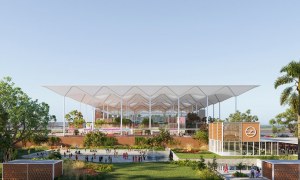🕑 Reading time: 1 minute
In Shanghai's eastern Huangpu district, a five-story primary school building, weighing 7600 tons, was relocated to a new location to make space for a commercial complex. The relocation was a rare sight as it used a "walking machine" technology without causing any damage to the building.
The city has a track record of relocating old buildings, but most of them have been rectangular or square in shape. The Lagena Primary School was a T-shaped building built in 1935, and the traditional methods of pulling or sliding may not have worked because it may not have withstood the lateral forces applied to it.
As per reports, this is the first time when a "walking machine" technique was used in moving a building as on its way to the new location, the building was also required to be rotated and follow a sinuous route instead of just moving in a straight path.
So the technicians came up with a plan to fit the building with almost 200 robotic devices, which operated as its "legs." Laborers dug around the building to install the mechanical supports underneath. These legs were equipped with wheels that allowed a smooth movement to this 85-year-old building, while the sensors attached to the building helped control its movement.
The supports, divided into two groups, rise up and down alternately and act like robotic legs to imitate the human walk in order to move the building forward.
It took about 18 days to move the building, during which it was rotated 21 degrees and moved 203 feet (62 meters) to its new location, where it will undergo renovation. The building is now set to become a center for heritage protection and cultural education.
Rapid urbanization continues to pose a serious challenge to heritage conservation. Though not the first choice, relocation is a better option than demolition. With innovation and technology like "walking machine," there is still some hope to preserve and protect monuments of significance.
Read More
Top 6 Wearable Technology in the Construction Field



